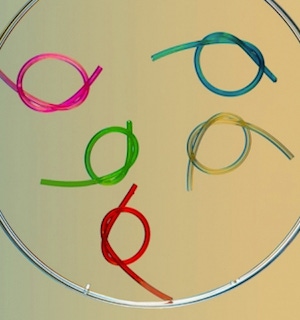“Hydrogel laminates” form an almost unbreakable bond with elastomer-based devices while imparting a soft, slippery feel.
July 19, 2017

You don’t often see catheters and condoms mentioned in the same sentence, but they do share a couple of traits: Both products are regulated by FDA and lubricity is a desirable property. Engineers at the Massachusetts Institute of Technology (MIT; Cambridge) have developed a gel-like coating that can be applied to plastic or rubber devices to impart a softer, more slippery feel and ease patient discomfort or enhance pleasure, as the case may be.
|
Even after MIT researchers tied the coated tubing into a knot, the hydrogel coating remained strongly bonded and |
In a paper published this week in the journal Advanced Healthcare Materials, the team describes a method for strongly bonding a layer of hydrogel to common elastomers such as latex, rubber and silicone. The results are “hydrogel laminates” that are at once soft, stretchable, slippery and impermeable to viruses and other small molecules. The coating can even be tailored to monitor and treat signs of infection.
The hydrogel coating can be embedded with compounds to sense, for example, inflammatory molecules. Drugs can also be incorporated into the material and slowly released to treat inflammation.
The team, led by Xuanhe Zhao, the Robert N. Noyce Career Development Associate Professor in the Department of Mechanical Engineering at MIT, bonded layers of hydrogel onto various elastomer-based medical devices, including catheters and intravenous tubing. They found that the coatings were extremely durable, withstanding bending and twisting, without cracking, noted a press release on the MIT website. The coatings were also extremely slippery, exhibiting much less friction than standard uncoated catheters.
“Our first major focus was catheters, because they are rigid and not very comfortable,” explained lead author and graduate student German Parada. “Infection of catheters can cause around 50% of readmissions to hospitals.”
The group also coated hydrogel onto condoms and found that, in addition to enhancing the comfort of existing latex condoms by reducing friction, it could help improve their safety, since the hydrogel could be embedded with drugs to counter a latex allergy, the researchers said.
The hydrogel laminate’s dimensions can be tuned to accommodate different devices, according to the researchers. For instance, a thicker elastomer can be specified to increase the laminate’s rigidity or a thicker hydrogel coating can be used to incorporate more drug molecules or sensors. Hydrogels can also be designed to be more or less slippery, depending on the amount of friction desired.
“We’ve demonstrated hydrogel really has the potential to replace common elastomers,” Zhao said in a prepared statement. “Now we have a method to integrate gels with other materials. We think this has the potential to be applied to a diverse range of medical devices interfacing with the body.”
About the Author(s)
You May Also Like





